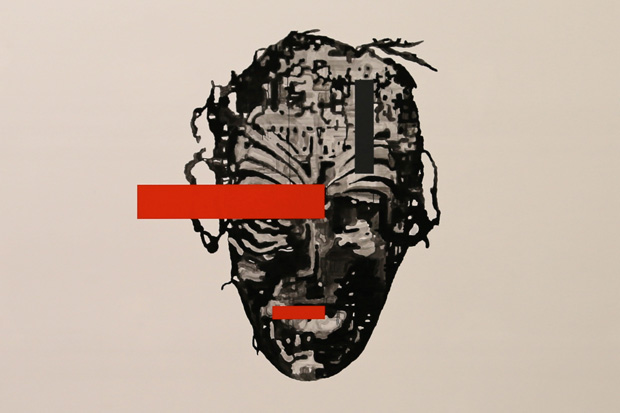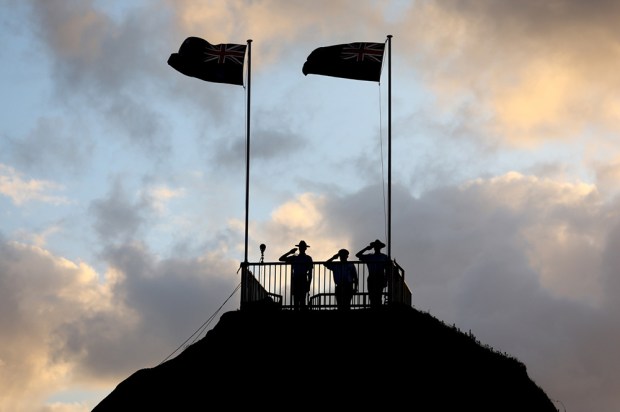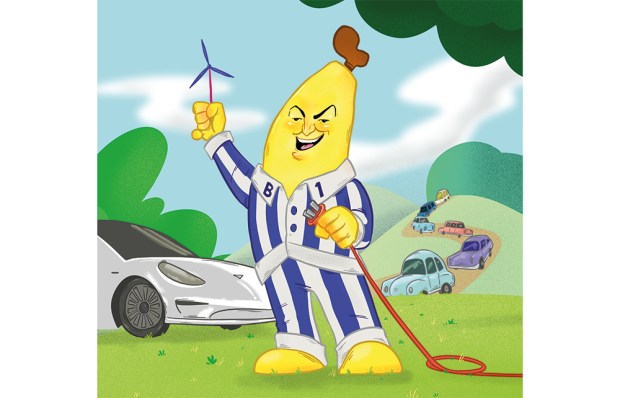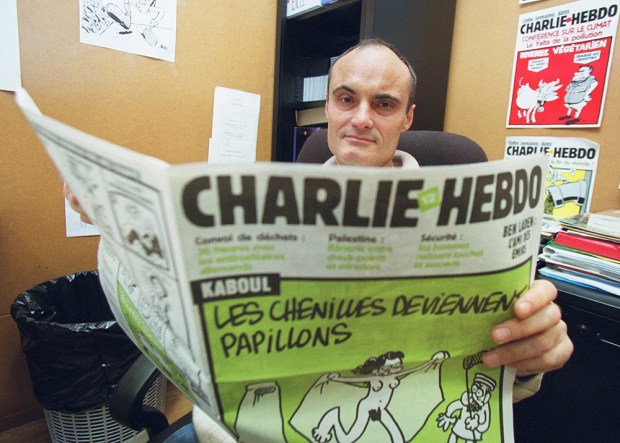Painted onto the pristine white wall of Shane Cotton’s latest exhibition Oblique Narratives is a disembodied Maori head. The head stares out from one eye; its second eye and mouth are blocked by two bright orange rectangles. The effect – a face rendered in dripping black paint, sliced by shapes that act as lurid reminders of modernity – is shocking.
New Zealand artist Cotton painted the mural from a 19th century photograph of a toi moko or a preserved, tattooed, Maori head. The eyes and brain were removed and the head was smoked over a fire then dried in the sun before being treated with shark oil. Kept in ornate boxes, they would be taken out for sacred ceremonies. Meanwhile, the preserved heads of enemies were traded with other tribes as a way to negotiate peace.
For millennia heads have fascinated collectors, artists, and warmongers. On the floor of Sydney’s Carriageworks gallery, in the same building as the Anna Schwartz Gallery where Oblique Narratives is showing until April 4, sits the vast toppled head of a giant aluminium Buddha sculptured by the Chinese artist Zhang Huan. Meanwhile, Isis have horrified the world with their videos of brutal beheadings.
‘There is something about the power of the imagery of the head,’ acknowledges Cotton, gazing up at his creation, Square Head, in a moment of quiet before the show’s launch. ‘I was really trying to think about the disconnect – what happens when the head is disconnected from the body? It plays in the back of my mind.’
For two decades Cotton, one of New Zealand’s best-loved artists, has explored his Maori and European roots through the use of both indigenous and Western folk art and symbols. Born in 1964 in Upper Hutt to a Maori truck driver father and an English/Scottish hairdresser mother, he graduated with a Fine Arts Degree from the University of Canterbury in Christchurch. His household was no-nonsense working class. He shrugs: ‘We didn’t have a lot of art around the home. [Art] wasn’t something our family was aware of.’ Growing up labelled ‘half-caste’, art offered escapism. ‘I think my art touches and reflects on ideas about distance and isolation. New Zealand is an island, and this reality creates a yearning to be connected to places and people beyond.’
It is telling, then, that birds often crop up in his work. Cotton is fascinated by these transformative animals endowed with supernatural powers in Maori culture who can fly between the living and the dead. Often he combines Maori motifs with symbols of European colonialism. One of his most enduring and confronting pieces, Needlework (1993) is an upturned pin-cushion, representing the untouched land, penetrated by Victorian hatpins and flags. Potted plants are another feature. In Oblique Narratives, near the entrance, is a mural of a black silhouetted potted plant. For Cotton (who has included imagery of basketballs and cowboy boots in previous works from the 1990s), greenery symbolises death and renewal.
‘It’s about starting a new life really’, he muses. ‘A lot is to do with colonisation… when you take something natural from the outside and place it in a pot, you actually control its growth. Not taming the land but you have guardianship over it – you nourish it and you get the fruits.’
Marrying the modern and traditional worlds together concerns Cotton, whose arms are covered with black ink tattoos. The swirling patterns are from his tribal area Northland and represent water. Similar designs are often painted underneath the hull of a waka, a Maori canoe. It’s about ‘being at one with the environment, being fluid, in the moment,’ he laughs, rolling up his sleeves. Also tattooed onto his arms are the names of his two daughters, Maia, 16, a fashion model, and Mika, 14. Cotton likes to view one arm – done by a skilled elder artist – as representing the past and the other – inked by someone much younger – as the future.
Looking back at Square Head, the Maori mural, he thinks for a while before stating that initially his rendition was ‘quite menacing. One of the decisions one has to make is which part of the face do you not reveal – which bits do you block out?’ Covering up the mouth renders the head voiceless. It is a powerful message. But the artist insists that these ‘are as much aesthetic decisions as they are conceptual ones.’ He is acutely aware that ‘sometimes the narrative or ideas behind the head can play ahead of the actual aesthetics and consumes it.’
In recent years, there has been a campaign to repatriate the hundreds of toimoko held in museums around the world. Cotton’s mural, for example, is a representation of a head initially stockpiled by Horatio Robley. The British Major-General, who served in New Zealand in the 19th century, donated his collection of dozens of toi moko to the American Museum of Natural History.
It is a fraught issue. And one that Cotton, softly spoken and apolitical, does not want to be drawn into. He likes the way his art ‘dips in and out’ of the present day, commenting, contributing, but never dictating a view. He is at pains to point out that he doesn’t ‘make any judgements about the past or anything in terms of what has become of them or what is going to happen to them. I just find compelling images which, as a painter, has allowed me to understand or discuss an aspect of the history.’ Cotton admits, however, that the expectation to take a stance as a prominent Maori artist ‘eventually bears down on you a wee bit.’ For Oblique Narratives he does not necessarily expect, or even want, his audience to be informed or have a view. ‘It does come from a place,’ he insists. ‘But you don’t have to understand the place to have an appreciation of the [art], you can just sort of respond to it.’ As for his own life work, Cotton is happy continually navigating, never finding answers but always seeking them. ‘You are always trying to create ground for yourself. You are continually moving through lots of different trial and error,’ he says. ‘That is the difficult thing. But also it’s what keeps you going.’
Got something to add? Join the discussion and comment below.
Get 10 issues for just $10
Subscribe to The Spectator Australia today for the next 10 magazine issues, plus full online access, for just $10.
You might disagree with half of it, but you’ll enjoy reading all of it. Try your first month for free, then just $2 a week for the remainder of your first year.














Comments
Don't miss out
Join the conversation with other Spectator Australia readers. Subscribe to leave a comment.
SUBSCRIBEAlready a subscriber? Log in